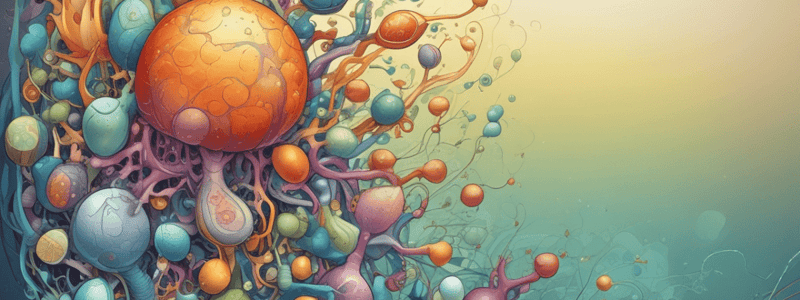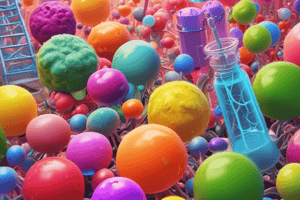Podcast
Questions and Answers
What is the primary source of energy for performing biological work in the body?
What is the primary source of energy for performing biological work in the body?
- The energy stored in the bonds between atoms of molecules
- The energy produced through anabolic reactions
- The energy generated from ATP
- The energy from the food we eat (correct)
What are the three major metabolic destinations for the principle nutrients?
What are the three major metabolic destinations for the principle nutrients?
- Energy for active processes, synthesized as fat or glycogen, and functional molecules
- Energy for active processes, structural molecules, and functional molecules
- Synthesized into structural molecules, synthesized as fat or glycogen, and ATP production
- Energy for active processes, synthesized into structural or functional molecules, or synthesized as fat or glycogen (correct)
What is the term that refers to all the chemical reactions in the body?
What is the term that refers to all the chemical reactions in the body?
- Catabolism
- Metabolism (correct)
- Anabolism
- Energy transfer
What is the molecule that plays a key role in the transfer of manageable amounts of energy from one molecule to another?
What is the molecule that plays a key role in the transfer of manageable amounts of energy from one molecule to another?
What is the outcome of oxidation reactions in biological systems?
What is the outcome of oxidation reactions in biological systems?
What is the term that describes the process of transferring hydrogen atoms from one compound to another through coenzymes?
What is the term that describes the process of transferring hydrogen atoms from one compound to another through coenzymes?
What is the opposite of oxidation?
What is the opposite of oxidation?
What is the primary source of energy for synthesizing ATP in the body?
What is the primary source of energy for synthesizing ATP in the body?
What is the process by which glucose is stored in the liver and skeletal muscles?
What is the process by which glucose is stored in the liver and skeletal muscles?
What is the role of insulin in glucose movement into cells?
What is the role of insulin in glucose movement into cells?
How is glucose absorbed in the GI tract?
How is glucose absorbed in the GI tract?
What is the fate of excess glucose when glycogen storage areas are filled up?
What is the fate of excess glucose when glycogen storage areas are filled up?
What is the primary function of ATP in biological systems?
What is the primary function of ATP in biological systems?
Which process involves the removal of electrons from a molecule?
Which process involves the removal of electrons from a molecule?
What happens to the liberated hydrogen atoms during oxidation reactions?
What happens to the liberated hydrogen atoms during oxidation reactions?
What is the term that describes the breaking down of complex organic molecules?
What is the term that describes the breaking down of complex organic molecules?
What is the relationship between catabolism and anabolism?
What is the relationship between catabolism and anabolism?
What is the energy source for performing biological work?
What is the energy source for performing biological work?
What is the fate of the energy stored in the bonds of nutrient molecules?
What is the fate of the energy stored in the bonds of nutrient molecules?
What is the role of coenzymes in oxidation reactions?
What is the role of coenzymes in oxidation reactions?
What is the purpose of metabolic reactions in the body?
What is the purpose of metabolic reactions in the body?
What is the result of the coupling of catabolism and anabolism?
What is the result of the coupling of catabolism and anabolism?
Flashcards are hidden until you start studying




